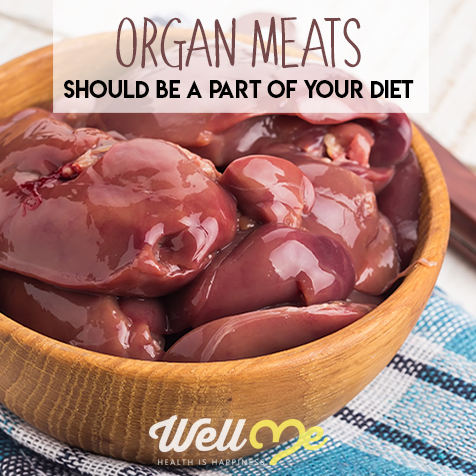Organ meats are a large part of the diets of other cultures but have not made it into the mainstream United States culinary culture. The liver, kidneys, and heart are packed with nutrients and have their own amazing health benefits. Organ meats are an easy way to improve your diet and pack in rare nutrients in a bioavailable form.
Organ meats may not sound particularly appetizing – they are not the most glamorous foods in existence – but they provide a fantastic nutrient profile. Today we’re going to share some of the most amazing benefits of different organ meats and how they can affect your overall health and wellness.
Why Don’t You Know About Offal?
Organ meats are referred to as offal – a word that tends to put people off. Offal was a large part of the food industry prior to large-scale farming and has played a significant role in traditional Anglo-American food for centuries. It is less popular lately due to the development of a national diet that prefers “food products” to unprocessed foods.
The decline of offal and organ meats has closely followed the removal of whole foods from the American diet. The American diet is increasingly reliant on processed foods from mass-produced factory farms, which has made organ meats like liver and kidney less popular but has also reduced the quality. Animals that have been force-fed and treated with harsh chemicals have poor organ health, making their organ meats unappealing and often unhealthy. You wouldn’t want to eat the liver of a cow with fatty liver disease!
The Benefits of Organ Meats
The benefits associated with offal are extensive but have not been enough to put it on the map in recent years. It may be the case that the benefits have simply been forgotten, but more likely that they have fallen by the way-side in favor of more common factory-produced skeletal muscle meats like beef and pork. Even so, organ meats provide the following benefits:
Protein
Organ meats are incredibly dense in protein, with liver providing 65% of its total calories from protein and offering a great source of animal protein with a wide variety of nutrients. This protein content is comparable to other forms of meat, while its nutrient-density is more comparable to that of salmon or plant foods. Kidney has an even higher 73% protein content and has a comprehensive nutrient profile of its own. Heart has a 74% protein content and, as with other organ meats, a well-rounded nutrient profile.
Protein is an essential part of the diet for tissue recovery and muscle growth and also aids in fat loss. By consuming organ meats in combination with other healthy foods, you can boost the quality of your diet and increase nutrient intake while keeping calories low and protein high. These are all the key ingredients for rapid, sustainable, healthy weight loss.
Liver
Liver is a great source of key nutrients such as iron and zinc. These essential minerals are primarily involved in the regulation and maintenance of blood and heart health, and deficiency in both is common in the United States.[1] A diet richer in organ meats like liver could easily address this deficiency, reducing cases of anemia and stunted sexual-hormonal development.
Liver is also rich in Vitamins A, B5 and 12, as well as trace minerals like copper (important or iron metabolism)[2] and selenium. As with iron and zinc, these are compounds that are generally less common in the American diet and would be a great boost to health if consumed in the bioavailable form found in liver and other organ meats.
Vitamin A is the star of the show for liver and is related to a variety of processes. Not only is vitamin A profoundly antioxidant, it is also a pigment meaning that it has a huge impact on the health of the skin, eyes, and hair. Vitamin A is found in huge quantities in beef liver, at levels so high they were initially considered to be toxic. Later research exonerated vitamin A, showing that it is totally healthy in doses of around 50,000IU. This is more than 3 times greater than other organ meats, and dozens of times greater than the closest fruit or vegetable.
Concerns have been raised over the cholesterol content of liver: it has a very high cholesterol content and is relatively calorie-dense. This makes it a reasonable choice 1 to 2 times per week with a large accompaniment of green leafy vegetables. However, it is important to note that dietary cholesterol and blood cholesterol are totally different and there is no necessary link between the two. Exercise portion control with liver, but don’t be put off by the high fat content.
Kidney
Kidney has many benefits similar to liver: it is a superior protein source, but also contains an increased amount of B2, B3, B9, and B12. This B-complex is extensive and provides some of the most important and sought-after nutrients for health and wellbeing in a digestible, bioavailable format.
Kidney is dense in zinc and copper, as well as slightly smaller quantities of both iron and selenium. Between a comprehensive B-vitamin complex and these trace minerals, kidney is a great choice for improving protein intake while simultaneously boosting micronutrient intake. This is a recurring theme across all organ meats – they contain large quantities of protein while also providing micronutrients that are much less common in skeletal muscle like beef.
Heart
Heart has fallen out of popularity primarily because of the difficulty in butchering it, the lack of knowledge on how to cook it, and the ignorance to its huge health benefits. Of course, the main reason heart is not more common in the American diet is also the fact that it is a relatively grisly thing to eat the heart of another animal and doesn’t fit well with modern sensibilities.
However, the idea that eating an animals heart gives you its strength is popular in many hunter-gatherer societies, perhaps because of the huge protein and nutrient profile compared to any other form of muscle. Cardiac muscle is structurally different from skeletal muscle (that makes up your visible muscles, and most types of meat), and this translates to a totally different nutritional profile with high protein content and a great mixture of micronutrients.
Heart is perhaps the least nutrient-dense of the organ meats, but has the highest protein content. It should also be seen in comparison with other forms of muscle, rather than organs. While heart has the lowest nutrient content of the main organ meats, it is far more nutrient-rich than other meats while having the same protein content as chicken breast. In this sense, heart can be considered one of the most nourishing organ meats despite its high cholesterol content.
Organ Meats and Toxicity
Questions have been raised over the efficacy of organ meats as part of the diet, primarily due to their content of essential minerals and their intended role in the body.[3] Organs like the liver and kidneys are responsible for filtering toxins and improving the health of the whole animal, meaning that they are more susceptible to problems of excessive concentration of trace minerals and may even contain the very toxins that they have been used to clear from the body.
The problem with this theory is that organs like the liver and kidney do not absorb toxins, but filter them from the blood and digestive system before depositing them in either the urine or excrement. A well-dried and butchered beef liver will not retain any potential toxins from the cow.
Instead, the liver and kidneys store the necessary vitamins and minerals associated with the removal of these compounds from the body. While you may fear that filtering systems contain the contaminants they evolved to filter, they actually contain the chemicals used to filter toxins – this makes them a great option for decreasing levels in your own body!
The Risk of Organ Meats: Quality Matters
The real problem with organ meats in modern America is the uncompromising need for quality: the liver, kidneys, and heart are at risk of developing visceral fat deposits in poorly-raised animals. The rise of factory farming has posed a real problem for organ meats through the decreased quality of rearing conditions for common cattle like cows, chicken, and hogs.
The development of a farming model that focuses on maximizing profit and selling cheap meats is not compatible with the production and sale of healthy organ meats. Animals that have been factory-farmed are often force-fed to develop well beyond their natural size. This spectacular increase in size and poor living conditions causes fatty liver disease and similar problems in animals, much like obesity causes non-alcoholic fatty liver disease in humans.
With organ meats being quick to spoil, difficult to market, and requiring the highest quality farming standards, they have fallen out of popularity in the modern animal food market. When buying organ meats, it is important to ensure that you select the finest quality sources with a focus on organic or grass-reared animals, avoiding commercially-reared animals. For this reason, you are likely to get the best quality of produce from your local butchers – these grassroot stores tend to source their cuts from local, responsibly-reared cattle and other animals, ensuring quality and proper health.
Quality matters far more in the selection and consumption of organ meats for a variety of reasons. The quality of the product is closely related to the health of the animal, the freshness of the product, and the lifestyle that the animal lived. These are hard to keep track of in the modern meat industry, but they make a huge difference to the way that organ meats affect your health.

Summary: What Should You Do Now?
Organ meats can provide a wide variety of the most commonly-deficient vitamins and minerals in their most concentrated and bioavailable forms. For instance, liver is renowned for its high levels of vitamin b12, b2, and A, as well as iron, whereas tripe boasts many minerals and vitamin b12.[4]
Add a small amount of offal to your dishes, perhaps even in combination with a dry meat like chicken or turkey breast, to add huge amounts of protein and micronutrients to your diet. These fatty cuts should be included regularly but in small doses to avoid excessive consumption of dietary cholesterol and other forms of calorie-dense fats.
These forgotten meats are far superior to anything you’ve seen in a supermarket before – while heart, kidney, and liver may not be as popular as pork or beef, they’re far healthier and provide a wealth of health-boosting effects.
References
- [1] http://circ.ahajournals.org/content/43/6/876.short
- [2] https://www.cambridge.org/core/journals/public-health-nutrition/article/worldwide-prevalence-of-anaemia-who-vitamin-and-mineral-nutrition-information-system-19932005/E201EDE33949AF3D632F6596052FCF8F
- [3] http://www.sciencedirect.com/science/article/pii/S0160412011000481
- [4] https://www.nm.org/healthbeat/healthy-tips/nutrition/guide-to-eating-organs








